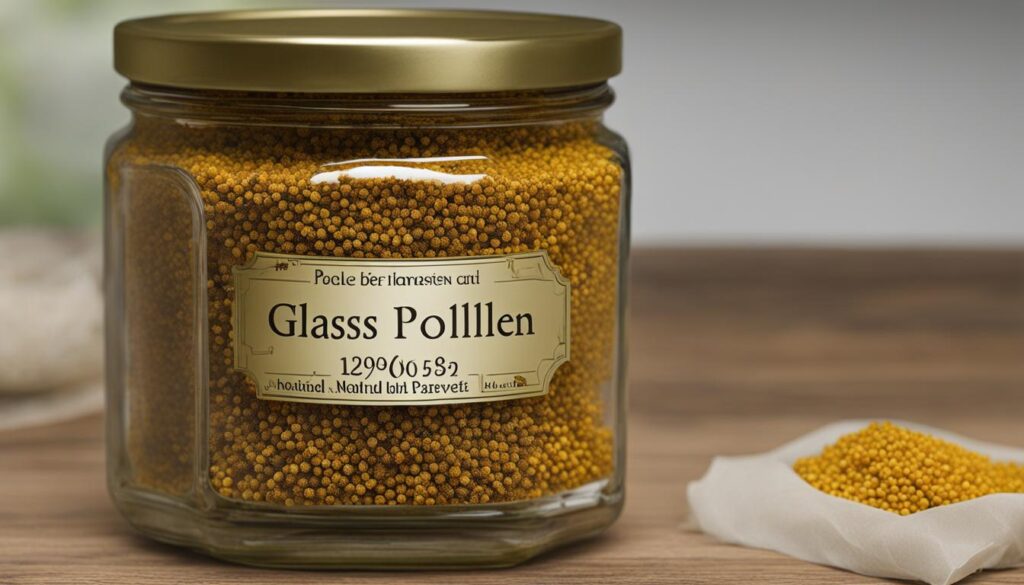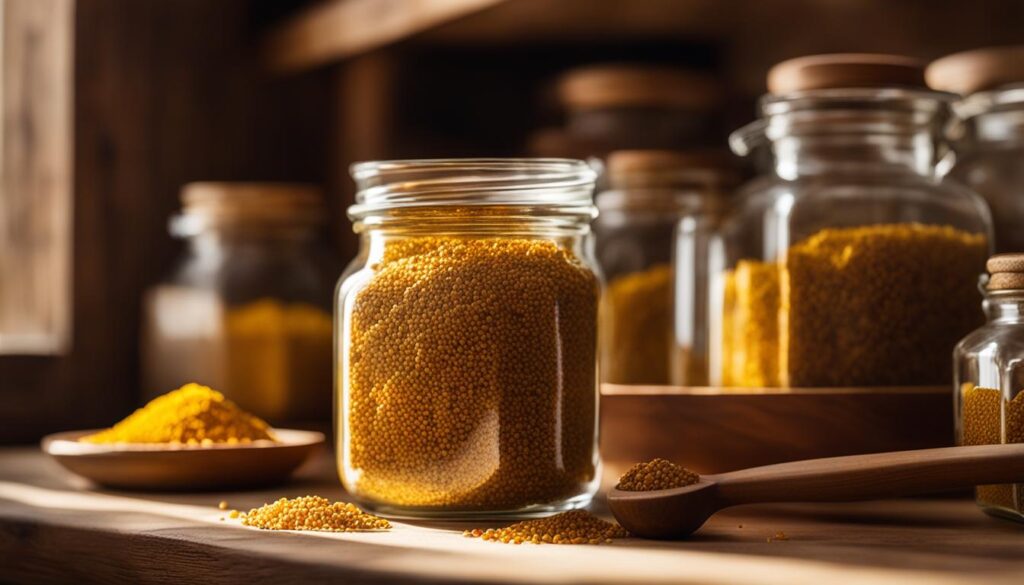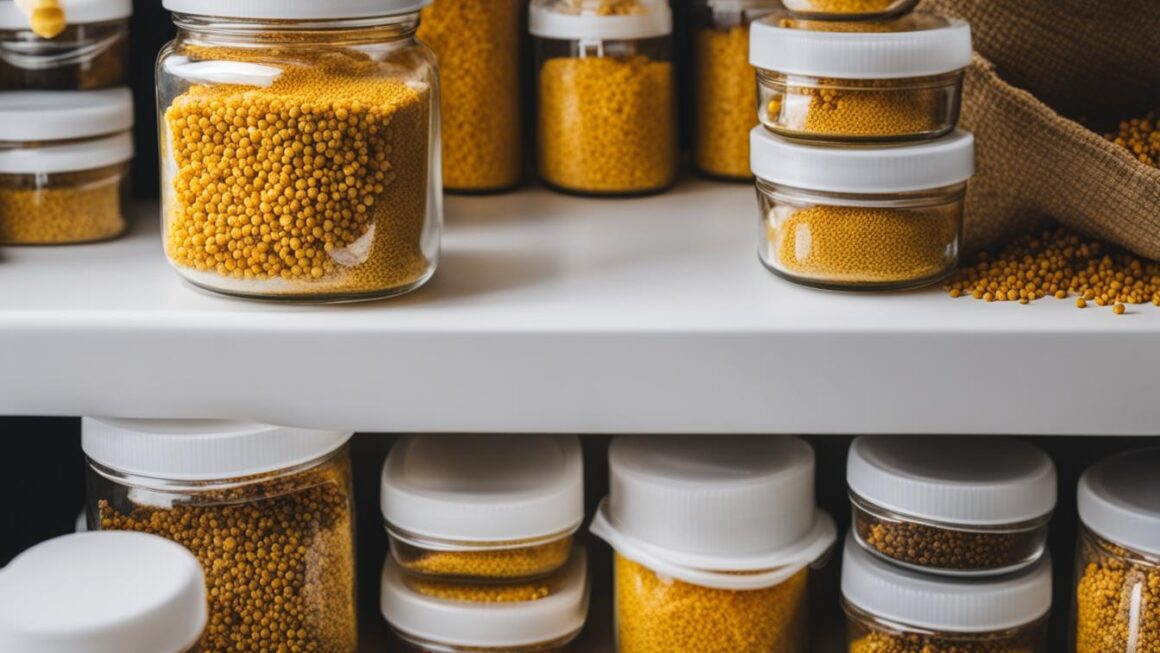Bee pollen is a highly nutritious superfood that is packed with essential vitamins, minerals, and antioxidants. To maintain its nutritional value, it is important to store it properly. In this comprehensive guide, we will provide you with expert advice on how to store bee pollen effectively and preserve its freshness.
Key Takeaways
- Proper storage techniques can help extend the shelf life of bee pollen and maintain its nutritional value.
- Choosing the right storage container, controlling temperature and humidity, avoiding contamination, and managing excess moisture are crucial for preserving bee pollen.
- Long-term storage methods such as freezing, drying, and vacuum sealing can help maintain bee pollen’s quality over time.
- Proper labeling and dating of stored bee pollen can help keep track of freshness and ensure it is consumed within the recommended timeframe.
- Reviving the freshness of stored bee pollen that may have lost some of its potency is possible with simple methods.
Understanding Bee Pollen
Before we dive into the best practices for storing bee pollen, let’s first understand what bee pollen is and why it’s important to handle it properly. Bee pollen is a fine powdery substance that bees collect from flowering plants. It’s considered a superfood due to its high nutritional content, with over 250 biologically active compounds including vitamins, minerals, amino acids, and antioxidants.
The freshness of bee pollen is crucial to maximize its nutritional value. Exposure to air, light, heat, and moisture can cause it to lose potency and spoil quickly. By following the proper storage techniques, you can maintain the freshness of bee pollen and extend its shelf life.
Some of the best practices for storing bee pollen include:
- Keeping it in a cool, dark, and dry place
- Choosing the right storage container
- Avoiding contamination
- Proper labeling and dating
- Managing excess moisture
“Bee pollen is one of nature’s most complete foods, containing nearly all essential nutrients required by humans.” – Dr. Joseph Mercola
Bee pollen is widely recognized for its numerous health benefits, including boosting the immune system, enhancing energy levels, improving digestion, and reducing inflammation. It’s also believed to have anti-aging properties and aid in weight loss.
To ensure that bee pollen retains its nutritional value, it’s essential to store it correctly and handle it with care. In the following sections, we’ll explore the various techniques and tips for storing bee pollen to maintain its freshness and potency over time.
Choosing the Right Storage Container
When it comes to storing bee pollen, choosing the right container is crucial. To ensure proper storage of bee pollen, it is essential to select a container that is airtight, moisture-proof, and keeps the pollen away from sunlight.
One of the best options for storing bee pollen long-term is glass jars with an airtight seal. These jars offer excellent protection from moisture and air exposure, and unlike plastic, it does not release harmful chemicals into the stored pollen.
For larger quantities of pollen, a food-grade plastic container with an airtight lid is also an option. However, it’s crucial to make sure that the container is made of high-quality plastic that won’t leach chemicals into the stored pollen.
Avoid Containers That Can Compromise Bee Pollen’s Quality
Avoid using a container that can compromise the quality of stored bee pollen. Containers made of metal or low-quality plastic can corrode and release chemicals that can contaminate the pollen. Similarly, paper bags or cloth bags may let in moisture and air, compromising the pollen’s freshness and potency.
Temperature and Humidity Control
Storing bee pollen for maximum potency requires optimal temperature and humidity conditions. The ideal temperature for storing bee pollen is between 32°F and 41°F (0°C and 5°C). Storing it at room temperature, above 68°F (20°C), can lead to degradation of its nutritional value and quality.
Avoid exposing bee pollen to humidity and moisture as it can stimulate fungal and bacterial growth, reducing its freshness and potency. For maintaining the freshness of bee pollen, you must keep it dry. It’s important to store the pollen in an airtight container to prevent moisture from entering.
How to Create a Suitable Storage Environment
Here are some tips for creating a suitable storage environment for bee pollen:
- Store the bee pollen in a cool, dry place or in a refrigerator.
- Use airtight containers such as glass jars with tight lids or vacuum-sealed bags to prevent moisture and air from entering.
- Avoid using plastic containers as they may affect the quality of bee pollen. Instead, use glass or ceramic jars or other food-grade storage containers.
Moreover, always avoid storing bee pollen near sources of heat or light, including direct sunlight. These factors can accelerate oxidation and spoilage, affecting the quality, freshness, and nutritional value of stored bee pollen.
By following these tips for storing bee pollen, you can maintain its freshness and nutritional value, ensuring you can enjoy its benefits for an extended period.
Avoiding Contamination
When storing bee pollen, it is crucial to keep it free from any contaminants. Even a small amount of moisture, dirt, or other impurities can compromise the nutritional value and freshness of the pollen. To ensure you store bee pollen correctly, follow these tips:
- Use only clean and dry storage containers
- Avoid using containers that have been previously used for other foods
- Wash your hands thoroughly before handling bee pollen
- Avoid storing bee pollen near strong-smelling substances, as it can absorb odors easily
- Consider covering the container with a clean cloth or paper towel to prevent dust and debris from settling on the pollen
By taking these precautions, you can help ensure that your stored bee pollen remains pure and uncontaminated. This will help maintain its nutritional value and freshness, so you can continue to enjoy its benefits for an extended period.
Long-Term Storage Methods
When it comes to storing bee pollen for extended periods, there are several techniques you can use to maintain its quality over time. Here are some best practices for storing bee pollen long-term:
- Freezing: One of the most effective ways to store bee pollen is by freezing it. This method can help preserve its nutritional value for up to two years. To freeze bee pollen, place it in an airtight container and store it in the freezer at 0°F (-18°C). When you’re ready to use it, thaw it slowly to avoid moisture buildup.
- Drying: Another method for storing bee pollen long-term is by drying it. This process helps remove moisture from the bee pollen, which can extend its shelf life. You can dry bee pollen by spreading it out on a clean, dry surface in a warm, well-ventilated area. Once it’s completely dry, store it in an airtight container in a cool, dry place.
- Vacuum Sealing: Vacuum sealing is another option for storing bee pollen long-term. This method can help protect bee pollen from exposure to air, which can cause it to deteriorate quickly. To vacuum seal bee pollen, place it in a vacuum-sealed bag or container and remove all the air before sealing it. Store it in a cool, dry place away from light.
Comparison of Long-Term Storage Methods
| Storage Method | Shelf Life | Pros | Cons |
|---|---|---|---|
| Freezing | Up to 2 years | – Preserves nutritional value – Easy to thaw and use |
– Requires freezer storage – Slow thawing process |
| Drying | Up to 1 year | – Removes moisture – Lightweight for storage – Easy to prepare |
– Requires warm, ventilated area to dry – Dried pollen can be powdery and difficult to handle |
| Vacuum Sealing | Up to 1 year | – Protects against air and moisture exposure – Easy to store |
– Requires vacuum-sealing equipment – May be more expensive than other methods |
When deciding which method to use for storing bee pollen long-term, consider your storage needs and available resources. Each method has its pros and cons, so choose the option that best fits your circumstances.
Proper Labeling and Dating
Proper labeling and dating are essential for preserving bee pollen and maintaining its freshness. When storing bee pollen, it’s easy to forget when you first received it, or how long it’s been stored.
Label the storage container with the date of purchase or receipt, and the use-by date. This will help you to keep track of the freshness of the stored bee pollen and ensure that you consume it within the recommended timeframe.
“By labeling and dating stored bee pollen, you can monitor its freshness and make sure it’s used before it loses its nutritional value.” – Beekeeping Expert
Also, remember to include the type of bee pollen on the label. Different types of bee pollen have different nutritional values, and you’ll want to keep track of which type you are consuming.
| Labeling Tips: | Dating Tips: |
|---|---|
|
|
By properly labeling and dating your stored bee pollen, you can ensure that you are consuming it at its freshest and most nutritious state, preserving its benefits for your health and wellbeing.

Managing Excess Moisture
Excess moisture is the enemy of stored bee pollen, as it can cause spoilage and reduce its nutritional value. Follow these bee pollen storage tips to manage excess moisture and maintain the freshness of your stored pollen:
- Choose the right container: Opt for an airtight container made of glass or food-grade plastic. Make sure the lid fits tightly to prevent moisture from seeping in.
- Absorb the moisture: Place dry rice or silica gel packets in the storage container to absorb moisture and prevent spoilage. Remember to replace them periodically to ensure they are still effective.
- Avoid temperature fluctuations: Fluctuations in temperature can cause condensation to form inside the storage container, leading to excess moisture. Store the container in a cool, dry place away from direct sunlight and heat sources to prevent temperature fluctuations.
- Use a dehumidifier: If you live in a humid climate, it may be useful to invest in a dehumidifier to reduce moisture in the air. This can help prevent excess moisture from affecting your stored bee pollen.
By managing excess moisture, you can preserve the nutritional value and freshness of your bee pollen for longer periods.
Storing Bee Pollen in Your Pantry
If you’re like most people, you probably store a lot of food items in your pantry. But did you know that certain storage conditions can affect the quality of bee pollen? To ensure that your bee pollen stays fresh and nutrient-packed, it’s important to follow these tips for storing bee pollen in your pantry:
- Keep the bee pollen in a cool, dry place, away from direct sunlight and heat sources.
- Store the bee pollen in an airtight container to prevent exposure to moisture and air.
- Avoid storing the bee pollen near strong-smelling items, such as spices or onions, as it can absorb odors and flavors easily.
- Label the container with the date of purchase and the expiration date to ensure that you consume the bee pollen within the recommended timeframe.
By following these guidelines, you can ensure that your bee pollen stays fresh and potent for longer.

Reviving Bee Pollen’s Freshness
Over time, stored bee pollen may lose some of its original potency. However, there are simple techniques you can use to revive its freshness and restore its nutritional benefits.
One method is to place the bee pollen in a warm, dry environment, such as an oven on low heat. Allow the bee pollen to warm up for a few minutes, but be careful not to overheat it, as this can damage its nutritional properties. Once warmed up, remove the bee pollen and let it cool to room temperature before storing it again.
Alternatively, you can also blend the bee pollen into a fine powder and mix it with a small amount of honey or water. This method can help rejuvenate the freshness of the bee pollen and make it easier to consume.
Remember to store revived bee pollen the same way you would store fresh bee pollen, in a dry, airtight container, away from moisture, light, and heat sources.
Conclusion
In conclusion, proper storage techniques are essential for maintaining the freshness and potency of bee pollen. By following the tips and methods shared in this comprehensive guide, you can extend its shelf life and preserve its nutritional value for an extended period.
Remember to choose the right storage container that protects bee pollen from moisture, light, and air exposure. Create an optimal storage environment by controlling temperature and humidity levels to prevent spoilage. To avoid contamination, keep bee pollen free from contaminants and excess moisture.
Long-term storage options such as freezing, drying, and vacuum sealing are excellent methods to preserve its quality over time. Ensure proper labeling and dating of stored bee pollen, and store it in your pantry according to the recommended conditions and storage methods.
If your stored bee pollen has lost some of its original potency, revive its freshness by following the simple methods shared in this guide.
By implementing these best practices for storing bee pollen, you can enjoy its benefits while maintaining its nutritional value for an extended period.
FAQ
How should I store bee pollen?
Bee pollen should be stored in a cool, dry place away from direct sunlight and moisture. It is best to store it in an airtight container to prevent exposure to air and maintain its freshness.
How long does bee pollen last when stored properly?
When stored properly, bee pollen can last for up to two years. However, its nutritional value may gradually decrease over time, so it’s recommended to consume it within a year for optimal benefits.
Can I freeze bee pollen for long-term storage?
Yes, freezing bee pollen can help extend its shelf life. Ensure that it is stored in an airtight container to protect it from moisture and freezer burn. Thaw frozen bee pollen slowly in the refrigerator before using.
How can I prevent bee pollen from clumping together?
To prevent clumping, it is important to keep bee pollen dry. Avoid storing it in humid conditions and moisture-prone areas. Adding a desiccant packet to the storage container can also help absorb excess moisture.
Is it necessary to label and date stored bee pollen?
Yes, labeling and dating stored bee pollen is recommended. It helps you keep track of its freshness and ensures you consume it within the recommended timeframe. Use a permanent marker to clearly mark the date of storage.
Can I use bee pollen that has passed its expiration date?
It is generally recommended to avoid consuming bee pollen that has passed its expiration date. Over time, the nutritional value may decline, and there is a higher risk of contamination. It’s best to prioritize freshness and quality.
Can bee pollen be stored in the refrigerator?
While refrigeration can help maintain the freshness of bee pollen, it is not necessary if you store it correctly in a cool, dry place. Refrigeration may introduce excess moisture, which can affect the quality of the pollen.




